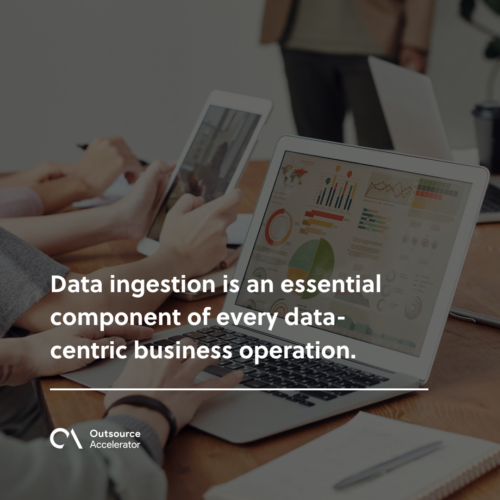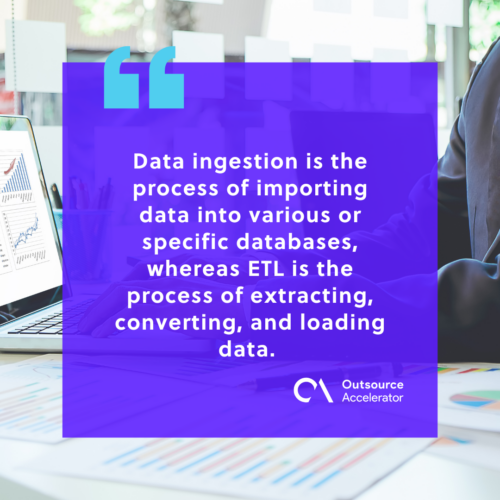Data ingestion 101: Everything you need to know

Businesses collect massive volumes of data daily. Managing all the incoming data takes a lot of work, and processing all these sets of information can be challenging.
Sometimes there are instances of misleading data analytic conclusions and inaccurate data reports. That’s why some business operations depend on data ingestion.
In this article, we’ll discuss everything you need to know about data ingestion, including its types, benefits, and challenges.
What is data ingestion?
Data ingestion is the method of receiving and importing data in a database. It is an essential component of every data-centric business operation.
This is where businesses may gather, store, and analyze data from various sources — allowing them to make wise decisions and improve their processes. Businesses that want to acquire data fast consider data ingestion because of its seamless data process.
For instance, a retail establishment may utilize data ingestion to monitor consumer purchases and examine patterns in a customer database to see if the data stored were accurate.

Usually, through data ingestion, all available information is kept in a specific type of database for safekeeping and efficient reports.
Data ingestion is also one of the essential elements of any data analytics pipeline. It’s because all available information can be ingested in the following data sources:
- Email marketing platforms
- CRM systems
- Finance systems
- Social media platforms
Data scientists often handle data ingestion since it necessitates knowledge of machine learning and programming languages such as Python and R.
3 main types of data ingestion
Here are the three main types of data ingestion:
Batch processing
Data ingestion gathers data from sources over time and provides batches to the application or system that will use or store the data at once.
Real-time processing
This does not include any sort of data grouping. Instead, each piece of data is handled as a separate object and loaded as soon as the data ingestion layer recognizes it.
This process is used for applications that need real-time data.
Micro batching
Streaming systems such as Google Cloud Dataflow use this type of data ingestion. It separates data into groups yet ingests it in smaller increments, making it more appropriate for streaming data applications.
Data ingestion vs. Data integration
Data ingestion and data integration may appear as similar concepts, but they are different.
Like a funnel, data ingestion collects data from several sources and funnels it into a single location. This might come from several sources, including databases, files, and streaming data.
In contrast, data integration merges data from numerous sources into a single, readable format. This enables you to grasp the facts better and make more informed decisions.
Data ingestion vs. ETL
ETL and data intake are two completely separate processes. Data ingestion is the process of importing data into various or specific databases, whereas ETL is the process of extracting, converting, and loading data.
The primary difference between data intake and ETL is what each performs for you:
- ETL – Removes data from one system, alters it, and then loads it directly into another system for usage.
- Data ingestion – Compared to ETL, data ingestion is a simpler operation because it only transfers data, not alter or modifies it.
Further, these two procedures are essential for moving data from one system to another. Depending on your needs, you might need to use one or both of these techniques.

Benefits of data ingestion
Businesses may streamline their customer service process through data ingestion.
For example, because data ingestion imports data for immediate use, customer service representatives can provide their clients with fast and exceptional customer support.
Other benefits of data ingestion include:
- Accuracy – support agents can verify the integrity and accuracy of every piece of information using data ingestion tools.
- Flexibility – data ingestion tools can process various data types and large volumes of structured and unstructured data.
- Speed – companies may gather data from several locations and transport it to a single environment for quick access and analysis through data intake.
Challenges of data ingestion
Below we have the common challenges of data ingestion:
Fragmentation and integration
Fragmentation and integration of data from several distinct third-party sources into a single data pipeline can be challenging. Absorbing data from the same sources might end up being a duplicate copy.
Data quality
It might be difficult to maintain data completeness and quality during data ingestion. To provide accurate and practical analytics, checking data quality must be a daily practice of the data ingestion process.
Costs
Businesses may need to upgrade their servers and storage systems as data quantities increase, raising the total data input cost.
Complying with data security rules also makes the process more difficult and may increase the cost of data ingestion.
Data ingestion helps extract and transfer data faster
Overall, businesses may benefit from data ingestion in terms of decision-making, time, cost savings, and data security.
If you’re seeking a rapid and safe method to obtain and transfer the data you need, data ingestion is a viable option that is definitely worth considering!







 Independent
Independent




